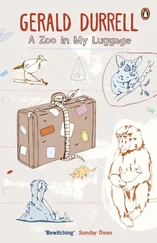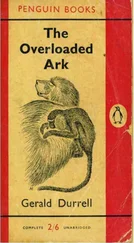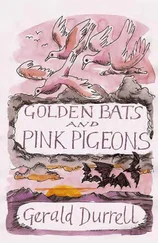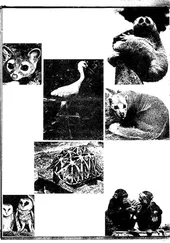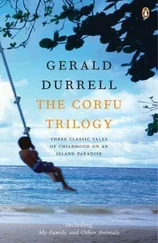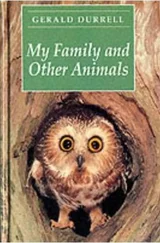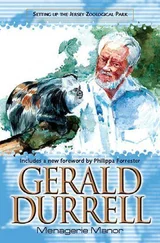Gerald Durrell - THREE SINGLES TO ADVENTURE
Здесь есть возможность читать онлайн «Gerald Durrell - THREE SINGLES TO ADVENTURE» весь текст электронной книги совершенно бесплатно (целиком полную версию без сокращений). В некоторых случаях можно слушать аудио, скачать через торрент в формате fb2 и присутствует краткое содержание. Жанр: Современная проза, на английском языке. Описание произведения, (предисловие) а так же отзывы посетителей доступны на портале библиотеки ЛибКат.
- Название:THREE SINGLES TO ADVENTURE
- Автор:
- Жанр:
- Год:неизвестен
- ISBN:нет данных
- Рейтинг книги:3 / 5. Голосов: 1
-
Избранное:Добавить в избранное
- Отзывы:
-
Ваша оценка:
- 60
- 1
- 2
- 3
- 4
- 5
THREE SINGLES TO ADVENTURE: краткое содержание, описание и аннотация
Предлагаем к чтению аннотацию, описание, краткое содержание или предисловие (зависит от того, что написал сам автор книги «THREE SINGLES TO ADVENTURE»). Если вы не нашли необходимую информацию о книге — напишите в комментариях, мы постараемся отыскать её.
THREE SINGLES TO ADVENTURE — читать онлайн бесплатно полную книгу (весь текст) целиком
Ниже представлен текст книги, разбитый по страницам. Система сохранения места последней прочитанной страницы, позволяет с удобством читать онлайн бесплатно книгу «THREE SINGLES TO ADVENTURE», без необходимости каждый раз заново искать на чём Вы остановились. Поставьте закладку, и сможете в любой момент перейти на страницу, на которой закончили чтение.
Интервал:
Закладка:
We soon found that the watery avenues around us were filled with a vast number of baby cayman of three different species. They ranged from six inches to three or four feet in length, and so were ideal as specimens. We found that the best time to hunt them was at night with the aid of a torch, for during the day they were far too wary to let you get very close, but at night you could dazzle them with a strong light. We would set off on these nocturnal hunts after dinner, paddling down the still, silent creeks, their waters still warm from the sun. The Amerindian paddler would be seated in the stern of the canoe, while Bob and I balanced precariously in the bows, armed with the torch, several tough bags and a long stick with a noose dangling at the end. We would paddle along silently until the torch beam picked out what appeared to be a pair of monstrous rubies lying on the mat of water plants and lily leaves that fringed the bank. We would make frantic gestures to the paddler, to indicate the direction he should take, and he, the blade of his paddle never breaking surface, would inch the canoe over the polished surface of the water as slowly and smoothly as a snail on a window-pane. The nearer we got to the fiery eyes the slower we went, until only a few feet would separate us from the water plants from which the cayman's head peered. Keeping the torch beam full in his eyes we would lower the noose, inch by inch, and work it carefully over his head, a manoeuvre that took a lot of practice but, once learnt, was easy to accomplish. As soon as the noose was over his head and behind his bulging eyes we would jerk the pole heavenwards, and the cayman would shoot out of the weeds like a rocket and dangle in the noose, wiggling frantically and giving harsh squealing grunts like a young pig. We were not always successful, of course; sometimes the paddler would misjudge the speed of the canoe, and its bows would touch the edge of the weeds, jarring the green surface slightly. There would be a loud plop, the cayman's head would vanish, and where it had been there would be only a ragged hole in the weeds, with the glinting water showing beneath.
One night we had met with such success on a cayman hunt that our bags were soon full and a chorus of grunts and coughs rose from the bottom of the canoe and made further quiet progress impossible. As it was still early we decided to send the canoe back to the village with our catch, while we waited for its return. So we landed on a convenient grassy bank, and while the canoe with its noisy cargo drifted towards the village Bob and I worked slowly up the edge of the creek, searching or frogs.
Now most people seem to be under the impression that a rug is just a frog the world over and that a species from South America is much the same as its English counterpart.
Nothing could be further from the truth, for in frogs, as in ather animals, you find that they vary from country to country, displaying a bewildering variety of shapes, sizes, colours, and habits. There is, for example, the so-called flying frog of Asia , a large tree-dwelling species that has developed elongated fingers and toes with wide webs between them. As this frog leaps from tree to tree it is supposed to spread its fingers and toes wide, so that the webs are taut and act like the wings of an aeroplane, allowing it to glide from tree to tree. There are the goliath frogs of West Africa that measure two feet in length and can eat a rat, and a pygmy South American species that you could accommodate comfortably on your little finger-nail. The male hairy frog, also of West Africa , has the sides of its body and its legs covered with thick pelt of what appears to be hair but is in reality composed of tiny filaments of skin. It also possesses retractile claws, like a cat. In coloration frogs are perhaps the only creatures that can seriously claim to rival birds; there are frogs coloured red, green, gold, blue, yellow, and black, while the patterns they adopt would make the fortune of any textile designer. But when it comes to rearing their young, then frogs really produce some startling results. The midwife toad of Europe , instead of leaving its eggs in the nearest water to latch unattended, hands them over to the male, who winds hem round his hind legs and carries them about until they hatch. There is a species of tree frog that glues two leaves together, and when water collects in the cup thus formed the Tog lays its eggs in this home-made pond. Another species makes a tree-top nest out of froth, resembling the nest of the so-called cuckoo-spit insect in England , and in this frothy nursery the eggs are laid. But before this happens the outside layer of froth has hardened, so that the inside is kept moist for the tadpoles. As soon as they are old enough to fend for themselves the hard outer casing dissolves and allows them to drop through into the water below.
Guiana has really more than her fair share of frogs that possess ingenious methods of safeguarding their eggs and young, and the creek lands proved to be the best place for catching them. Our first two discoveries we made that night while waiting for the canoe to return. Bob was amusing himself by dredging the creek with a long-handled net, while I prowled hopefully around some trees whose roots twisted and wound along the bank, half-submerged in the water. With the aid of the torch I succeeded in capturing three large tree frogs, dark green in colour, with great goggle eyes.
These proved to be Even's tree frog, a species in which the female carries her eggs stuck in rows along her back, like a section of a cobbled street. Unfortunately, none of the ones I caught were carrying eggs. I was just congratulating myself on this interesting frog capture, when there came a shout from Bob.
"Gerry, come and see what I've caught."
"What is it?" I shouted, as I put my tree frogs into a cloth bag and hurried down the bank towards him.
"I really don't know," answered Bob in puzzled tones, "but I think it must be some kind of fish."
He had the net half-submerged in the water, and swimming around in it was a creature that at first glance did appear to be some sort of fish. I looked at it closely.
"It's not a fish," I said.
"What is it, then?"
"It's a tadpole," I replied, after another scrutiny of the beast.
"A tadpole?" said Bob. "Don't be ridiculous. Look at the size of the thing. What sort of frog would that turn into?"
"I tell you it's a tadpole," I said firmly. "Look at it."
I dipped my hands into the net and pulled the creature out, while Bob shone the torch on it. Sure enough it was a tadpole, but the largest, fattest tadpole I had ever seen.
It measured about six inches in length, and its body was the size and circumference of a large hen's egg.
"It can't be a tadpole," said Bob, "but I don't see what else it can be."
"It's a tadpole all right, but what of?"
We stood and watched while the giant tadpole swam merrily round and round the glass jar we had confined him in. I racked my brains, for I knew that somewhere or other I had read about these monstrous tadpoles. After a few minutes of hard thinking it suddenly came back to me.
"I know what it is," I said, "it's a paradoxical frog,"
"A what?"
"A paradoxical frog. I remember reading about them somewhere. It's called that because instead of the tadpole being small and growing larger as it develops, it's the other way round."
"Other way round?" echoed Bob, completely bewildered.
"Yes, it starts off as a very large tadpole and as it develops it shrinks and eventually turns into a medium-sized frog."
"But that's ridiculous," said Bob again, "it should be the other way round."
"I know. That's why it's called a paradoxical frog."
Bob thought about it for a bit.
"I give up," he said at length. "What's the frog look like?"
Читать дальшеИнтервал:
Закладка:
Похожие книги на «THREE SINGLES TO ADVENTURE»
Представляем Вашему вниманию похожие книги на «THREE SINGLES TO ADVENTURE» списком для выбора. Мы отобрали схожую по названию и смыслу литературу в надежде предоставить читателям больше вариантов отыскать новые, интересные, ещё непрочитанные произведения.
Обсуждение, отзывы о книге «THREE SINGLES TO ADVENTURE» и просто собственные мнения читателей. Оставьте ваши комментарии, напишите, что Вы думаете о произведении, его смысле или главных героях. Укажите что конкретно понравилось, а что нет, и почему Вы так считаете.


